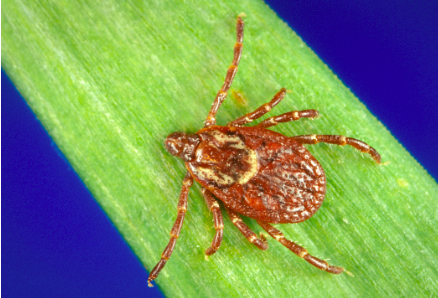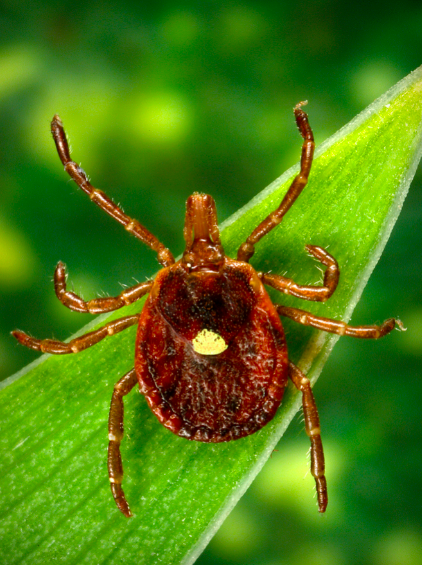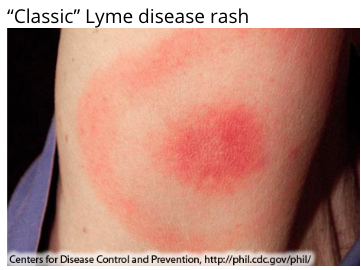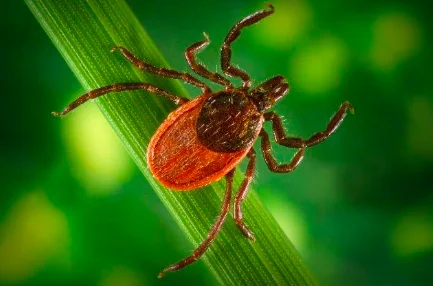Preventing tick bites-effective ways to repel ticks
(This post may contain affiliate links. See the full affiliate disclosure here for more info.)
Ticks were rare in Vermont, where I live, until a couple of decades ago. By rare, I mean that we only had dog ticks to worry about. Even the loggers, farmers, and hunters didn’t worry.
Now, it’s almost always tick season—except in the dead of winter—with peaks in late spring/early summer and fall. The primary hosts here are mice, white-tail deer, and dogs.

Ticks travel on grass and it used to be trimming the lawn and avoiding deep grass and bush-Ticks live in wooded areas, high grass areas, and leaf litter and travel on grass. It used to be that trimming the lawn and avoiding deep grass and bush-whacking in the woods were good ways to avoid a tick bite.
But none of that is true anymore.
Most ticks wait in the grass or brush to grab onto people or animals who pass by in a process called questing.
Now, they lurk everywhere and have developed ways to form a tick chain to get to a host they might not otherwise be able to reach. Lone star ticks also track a host by following the trail of their host’s breath. If you spend much time in the great outdoors, the chances of tick bites are good.
They truly are threats that need specific strategies to foil.
That’s why this is a good time for a lesson on ticks.
How to identify ticks
Yes, it’s important to prevent tick bites and repel ticks but if you get one on you, you’ll want to know what kind it is ASAP!
Ticks are tiny 3 to 5 mm parasitic arachnids (spider relatives) with 8 legs. The oldest known tick fossils are from the Cretaceous period, making them around 100 million years old. But I hope that doesn’t mean we’ll never be able to get rid of them.
According to the state of Vermont, there are 14 types of ticks here, 5 of which can cause disease in humans. That’s pretty scary. However, the black-legged tick, commonly known here as a deer tick, causes 99% of the diseases here.
The ticks you see may be microscopically small if they are certain types, at a certain life stage, or not embedded in your skin. Once embedded, they will become engorged with your blood and will be easier to detect.
KNOW HOW TO SAFELY REMOVE AN EMBEDDED TICK BEFORE YOU ATTEMPT IT (see below).
The main ticks in Vermont
Black-legged tick

These are the ticks that I fear. They hide in tall grass and prefer white-footed mice, deer mice, chipmunks, shrews, and white-tailed deer as their hosts. They cause a host of diseases (see below), including Lyme disease.
These ticks are abundant in Vermont and anyone outside is vulnerable.
American dog tick

Even though named dog ticks, rodents, small mammals like rabbits, cats, dogs, and humans are hosts for these ticks that carry Francisella tularensis, the bacteria that causes tularemia.
Tularemia is rare in Vermont but can be fatal. The symptoms vary but can include a very high fever, skin ulcers, and swollen glands.
So, when you help keep your furry friends tick-free, you are helping to prevent human tularemia infections.
Lone star tick

The name implies that this guy’s home is in Texas, but lone star ticks are now indigenous to Mexico and the eastern US.
These ticks like grassy areas and undergrowth and carry pathogens that cause ehrlichiosis with symptoms of fever, body aches, and tularemia.
However, because I read so many papers for my proofreading job, I know they also can cause alpha-gal syndrome, where the infected person experiences an allergic reaction to red meat.
Squirrel and Woodchuck ticks
These rarely bite humans, preferring squirrels and woodchucks, but both can cause Powassan, which is a horrible disease (see below).
Why ticks are so dangerous: Tick-borne diseases
Besides the fact that they carry potentially fatal diseases like tularemia, one tick can carry more than one disease. For example, the black-legged tick causes Lyme disease, anaplasmosis, babesiosis, Borrelia miyamotoi (tick-relapsing fever), and Powassan.
Lyme disease
Lyme disease is the most common vector-borne disease in the United States, caused by the Borrelia burgdorferi transmitted to humans by black-legged ticks, the carriers of Lyme disease. Infected people might experience fever, headache, fatigue, and a rash that looks like a target.
This is a characteristic of Lyme but does not appear in every case.

The reason Lyme disease is so bad is that If left untreated, it can spread to joints, heart, and nervous system. If you know you have been bitten by a black-legged tick or have a target-appearing rash, contact your doctor right away.
In most cases, the disease can be treated with a few weeks of antibiotics but if not treated, an accurate diagnosis and successful treatment are difficult, and patients report persistent Lyme symptoms.
Powassan
According to the Centers for Disease Control and Prevention (CDC):
- The symptoms of Powassan include fever, headache, vomiting, and weakness
- Powassan virus can cause severe disease, including infection of the brain (encephalitis) or the membranes around the brain and spinal cord (meningitis).
- Patients with severe disease might experience confusion, loss of coordination, difficulty speaking, and seizures.
Terrifyingly:
- Many people infected with Powassan virus do not have symptoms.
- For people with symptoms, the time from tick bite to feeling sick ranges from 1 week to 1 month.
- Approximately 1 out of 10 people with severe disease die.
- Approximately half of the people who survive severe disease have long-term health problems such as recurring headaches, loss of muscle mass and strength, and memory problems.
Borrelia miyamotoi
A Borrelia miyamotoi infection is also caused tick-relapsing fever. Borrelia is a spiral-shaped organism that can be acquired by a tick bite.
The symptoms include fever, chills, headache, and less commonly, body and joint pain and fatigue. A rash is uncommon, with fewer than 1 in 10 patients developing a rash.
Luckily, there are lab tests available to diagnose tick-relapsing fever, and patients are usually treated successfully with doxycycline.
Anaplasmosis
The symptoms of anaplasmosis are fever, headache, chills, and muscle aches. Doxycycline is used to treat adults and children with anaplasmosis.
Babesiosis
In babesiosis, the infectious organism invades red blood cells, and many patients don’t develop symptoms. Symptoms can develop from 1 to 9 weeks after being bitten by an infected tick and include fever, chills, sweats, headache, body aches, loss of appetite, nausea, or fatigue.
The spleen may try to remove these infected red cells, causing a special type of anemia called hemolytic anemia, which lasts from several days to several months. In severe cases, blood clots, organ failure, unstable blood pressure, and rarely, death may occur.
Visualizing the red blood cells under the microscope (a routine lab test) can help to make to diagnose babesiosis and there are special diagnostic laboratory tests. Patients can be treated with quinine and clindamycin or a combination of atovaquone and azithromycin.
Rocky Mountain Spotted Fever
Several ticks including the American dog tick, Rocky Mountain wood tick, and brown dog tick can carry the agent that causes Rocky Mountain Spotted Fever.
While it is believed that cases of Rocky Mountain Spotted Fever in Vermont likely are caused by trips outside the state, it worth knowing the signs and symptoms because this disease can be fatal.
The symptoms of Rocky Mountain Spotted Fever include fever, headache, rash that appears 2–4 days after the fever, muscle pain, lack of appetite. and a dark scab at the site of the tick bite.
Unfortunately, some patients who recover can experience permanent damage, including amputation of arms, legs, fingers, or toes; hearing loss; paralysis; or mental disability.
If treated early with doxycycline, severe illness and death can be prevented.
What to do if you see a tick on your body
Non-embedded tick
You might encounter a tick crawling on your skin or one embedded in your skin. Try to capture a non-embedded tick in your hand and flush it down the toilet or wash it off with a strong spray of water in the shower.
Embedded tick
The CDC gives this advice:
- Use clean, fine-tipped tweezers to grasp the tick as close to the skin’s surface as possible.
- Pull upward with steady, even pressure. Don’t twist or jerk the tick; this can cause the mouth-parts to break off and remain in the skin. If this happens, remove the mouth-parts with tweezers. If you cannot remove the mouth easily with tweezers, leave it alone and let the skin heal.
- After removing the tick, thoroughly clean the bite area and your hands with rubbing alcohol or soap and water.
- Never crush a tick with your fingers. Dispose of a live tick by
- Putting it in alcohol,
- Placing it in a sealed bag/container,
- Wrapping it tightly in tape, or
- Flushing it down the toilet.
See the CDC site for ways you should NEVER USE to remove a tick.
How to prevent tick bites
Some simple steps should become part of your outdoor routine. You can choose whatever suits you and your lifestyle, but regularly applying all of them is best.
After being outdoors, taking a few simple steps after being outdoors can help reduce the chance of a tick you’ve acquired latching on and causing disease or dropping off and infecting someone else.
Clothing
If you can strip outdoors, do so. Roll your clothes up and put them into the dryer at high temperature for at least 10 minutes. Then, you can safely put them into the hamper for washing in hot water without worrying about ticks dropping off to find another victim.
Body check
After stripping, do a complete body check. You might need another person’s help, a full-length mirror a couple of mirrors. Try to check all the parts of your body. However, ticks are small, and you might not see one. Especially check skin folds, between toes and fingers, and the groin area.
Be vigilant for several days, looking for ticks when you can.
Shower
Take a shower as soon as you can after being outdoors. Use a handheld shower sprayer if you have one, directing it at skin folds and the groin area.
Wash your hair. Use a conditioner. Some creamy, oily products may be able to smother a tick.
How to repel ticks naturally
Clothing
When planning to spend long periods outdoors, wear a light-colored long-sleeved shirt, long pants, socks, and shoes. Tuck in your shirt and tuck your pant legs into your socks.
Homemade natural tick repellents
I spray all my clothes with homemade tick spray when I go out. I concentrate on areas that aren’t covered, like my neck and hands, and areas where clothing meets at my waistline and ankles. Several are different types of natural repellents including essential oils.
1. Rose geranium oil repellent
This is not a 100% effective repellent, but it’s chemical-free and safe. The smell is not unpleasant—even though it’s made with rose geranium oil, it’s earthy, not floral— but dissipates.
It’s a good tick repellent to start with. The other recipes below add other essential oils to repel ticks.
Combine:
- 1/3 C water
- 1 tablespoon witch hazel (this helps the oil and water to mix). You can use up to ¼ cup
- 40 drops of rose geranium oil
Shake well and put it into a pump spray bottle for easy use.
Cedar oil
Cedar oil is a natural tick repellent that’s safe to use around people and pets. This homemade cedar oil tick spray recipe comes from DIY Natural. This tick spray contains garlic essential oil, and the smell might be a little off-putting. But, we are trying to repel ticks!
Keep this tick repellent in a dark glass spray bottle.
- 1 ounce grain alcohol
- 3 ounces distilled water
- 30 drops geranium essential oil
- 30 drops Virginia cedarwood essential oil
- 10 drops garlic essential oil
Variations
Some people recommend using a mixture of several essential oils. This may lead to a more fragrant tick repellent but also probably increase the odds of some ingredient(s) effectively repelling ticks.
This tick repellent recipe (a slight modification of one from Natural Kitchen Cooking School uses a combination of tick-repelling essential oils.
- 1/3 C water
- 1 tablespoon to ¼ cup witch hazel
- 30 drops each of lemongrass, peppermint, geranium, and cedarwood essential oils
Mix well. Store in a dark, glass spray bottle
A word about permethrin
Permethrin is not like DEET. It is not a repellent. It is an insecticide—meaning that it kills insects like ticks.
While topical creams containing permethrin are used to treat scabies, we are talking about ticks here and permethrin is not recommended for application to the skin for that purpose. Permethrin can be used to treat clothing and some companies sell permethrin-treated clothing.
You can find directions for treating clothing with permethrin here. A relative of mine took a school trip to Nicaragua and reported that they were instructed to treat their clothing with permethrin there.
A recent study by researchers at the CDC found that treated clothing could incapacitate several species of ticks or cause them to fall off the fabric. However, the clothes were not being worn by so they couldn’t say whether the permethrin kept ticks from biting. The study reported tick paralysis. A “1-minute exposure resulted in all ticks being unable to move normally, thus posing no more than minimal risk of biting 1 hour after contact with treated textile.”
A word about DEET
DEET, or N,N-Diethyl-meta-toluamide is an effective tick repellent but it’s a synthetic chemical. It was developed for soldiers in tropical forests and originally contained 75 percent DEET and 25 percent alcohol.
You’ve got to do your research, learn all you can, and weigh the risk of tick bites and infection from bites in your area versus the steps you can take to prevent tick bites and the risk associated with those steps.
It’s made to be applied to the skin or clothing as an insect repellent and comes in different concentrations. Concentrations of 10 to 30% are recommended for kids and it’s not recommended for infants under 2 months old.
DEET toxicity and even deaths have been reported and Health Canada banned the sale of higher concentrations over 30% in 2002, as did the state of New York in 1994. It is possible that applying DEET and sunscreen simultaneously might increase DEET penetration into the skin, so this should be avoided.
You’ve got to do your research, learn all you can, and weigh the risk of tick bites and infection from bites in your area versus the steps you can take to prevent tick bites and the risk associated with those steps.
Ways to decrease the tick population
Ultimately, the best way to prevent a tick bite is to reduce the tick population. One natural way to that can do this is to break the lifecycle.
Tick tubes
Tick tubes are simply old toilet paper tubes stuffed with lint treated with permethrin. The theory is that mice will take the stuffing and use it to line their nests, where it will kill ticks, breaking the cycle of infection.
I decided that this was a good mission to undertake and started to save dryer lint and toilet paper rolls at the beginning of the year. I combined a couple of bags of cotton balls that I tore apart and the stuffing from some packing material and had a good amount by the end of summer when mice would be making nests for winter.
I spread the material on a table that was covered with a cloth I intended to discard (now, I’m thinking of saving it for use with permethrin only). Wearing gloves, I put ready-to-use permethrin into a spray bottle and soaked the material. I left it outside to dry for about 24 hours and wearing gloves, I turned each piece over and soaked it all again.

Once it was dried, wearing gloves, I stuffed each end of the tubes. I ended up with nearly 4 dozen tubes.

Permethrin is safe for mammals and can be used to treat chickens with mites, but I didn’t want them pecking at and eating the tick tube stuffing. So, when I distributed the tubes, I tried to put them where the chickens couldn’t get them.
I put some in the attic, cellar, under the woodpiles, and under the porch. Most tick tube directions say to put them about 10 feet apart at the perimeter where the lawn meets a wooded or un-mowed area.
Last word on ticks
I hope that someday we have the last word on ticks, they become a thing of the past, and we can enjoy outdoor activities again without worrying about them. In the meantime, I will do my part to try to keep them off us and stop their infectious cycle.








